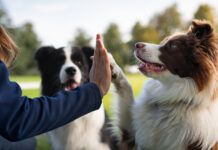When the newness of a pup wears off, it’s often replaced by a little bit of wondering—or sometimes grumbling—about how long it will be until the new family member becomes as well trained as the previous one: walking nicely on leash, coming instantly when called, not having accidents in the house, and responding to sit, down, stay, leave it, and other behaviors we teach dogs to help them fit into family life.
Can dogs learn everything they need to know in one eight-week puppy kindergarten or basic obedience class? No. That’s just a small part of your dog’s education.
Given the typical canine lifespan of 10-plus years, it’s all too easy to forget that the previous dog didn’t come fully loaded but required careful weeks, months and maybe even years of patient, consistent training and reinforcement to become the perfect dog of your memory. If you’re asking yourself “How long does it take to train a dog basic cues?” we’re here to help with information on factors that influence canine learning and how long it can take to teach particular skills.
How Learning Starts
It might seem as if neonatal puppies do nothing but eat and sleep, but from birth they are taking in scents and experiencing touch, both of which contribute to their knowledge of their surroundings, even if they can’t see or hear yet.
The critical period for learning is when pups are between 3 and 14 weeks old. By three weeks, their eyes and ears have opened and they’re mobile, if a little wobbly. They start using their paws and mouths to explore their environment.
With no preconceived notions about vacuums, cats, people in uniforms, or veterinary clinics, it’s the perfect time for them to have positive exposure to many different people, places, objects, sounds, surfaces, smells, and other environmental stimuli, known as socialization. With puppies being weaned and going to new homes when they are usually 8 weeks to 12 or more weeks old (later is often better if they’re in a situation where they receive a variety of socialization experiences), this type of activity can occur at the breeder’s home, in a foster home, or after the pup has come home with you.
Puppies should meet new people and animals and have new experiences multiple times a week rather than meeting the same neighbors and friends and going to the same places all the time. Those encounters and experiences should be so great that your puppy looks forward to anything new.
As puppies grow in experience, their brains grow too. The brain becomes larger and changes shape as its dendrites—specialized brain nerve cell structures that receive and process information—reach out to make connections with other nerve cells. By the time puppies are four months old, their brains are almost fully wired. Almost. Canine brains continue to develop until the dog is about two years old, so even if a pup looks grown-up, they still have a lot to learn, especially about impulse control.
Factors That Influence Learning
Socialization is an important element of learning, but it’s not the only one. How quickly your dog learns depends on several key factors:
- Maternal care and stress level during pregnancy
- Good puppy nutrition
- Genetic predisposition
- Learning style
- Training techniques
A mother dog’s stress level can affect the future behavior of her unborn puppies. If they experience high-stress situations before giving birth, their pups may be more anxious or fearful in stressful or unexpected situations. These young dogs can benefit from additional or intensive socialization.
Feeding a high-quality puppy food containing DHA from fish oil has been shown in studies to improve learning ability—cognition, memory, and psychomotor skills—in puppies up to a year old. Puppies eating high-DHA diets appeared to have stronger responses to training.
Breed or mix is important because different breeds have different types of skills and intelligence. That doesn’t make certain breeds “smarter” (Border Collies, Poodles, we’re looking at you), but it can affect not only how they learn but also how quickly they learn. Here’s what to know about certain types of dogs:
- Herding, working, and sporting dogs (including Poodles, which originated as water-retrieving dogs) tend to have a reputation for being fast learners.
- Some dogs may seem as if they haven’t caught on to something, but often they are sitting, watching, and thinking, later demonstrating that they’ve absorbed the lesson. This type of learning is often seen in hounds and guardian dogs, says veterinarian, breeder and trainer Deb Eldredge, but any dog may learn this way.
- Independent dogs tend to have good problem-solving skills. Sometimes that makes it difficult to stay a step ahead of them.
- Toy dogs and non-sporting dogs—the latter group being a miscellaneous assortment of unrelated breeds—are just as smart and capable of learning as bigger dogs. Don’t neglect training them just because they’re small, cute, or lack a discernible skill!
Puppies in general are “sponges,” learning things quickly—often the things we don’t want them to learn—but they also have short attention spans. Short, sweet training sessions that end on a high note are more effective than long, intensive ones. Rewards help dogs to understand what you want and to be more excited about repeating a particular behavior.
The presence of another dog as a teacher’s aide can also be helpful. It’s not unusual for dogs to mimic what they see other dogs doing, especially if they see those dogs being rewarded for a behavior. This has frequently worked well in my dog-training life.
The power of instinctive behaviors is a factor, too. Beagles, for instance, have great nose intelligence, but they’re probably not going to be very good at herding sheep, says Minnesota dog trainer and Beagle owner Denise Nord.
Training Time
Theory is all well and good, but how long does it take to train a dog on basic cues? The answer—“It depends”—is unsatisfying, but bear in mind that dogs learn most quickly with practice and patience. Start with easy behaviors and build on your—and your dog’s—successes.
Sit may well be the behavior that dogs learn most easily and quickly. It’s a natural action, making it easy to “capture” by clicking and treating when the dog is already in position or luring the dog into position with a treat. Using those techniques, dogs can learn “Sit” within the space of a few minutes.
The trick is then putting a name to the act and practicing and reinforcing it over time so that muscle memory kicks in immediately when dogs hear the cue. That takes longer, from a few weeks to a few months. Practice in different situations, different places, around different people, and around other animals: this is how you “proof” your dog so that response to “Sit” is immediate, no matter what. It pays off throughout life with your dog sitting at the door, to greet people, before meals, or as part of an agility or rally competition, to name just a few of its uses.
Similar techniques work well with “Down” and “Stand.” I find it easiest to capture a down rather than luring a dog into place, but a good mantra is “Every dog is different.” Do what works for you and your dog. Like “Sit,” it takes time and practice to get a reliable response every time.
A more complex behavior to teach is walking on leash without pulling. Unless you’re training for obedience competition, there’s no need to require a dog to walk exactly at your side all the time, but they should be well-mannered enough that you don’t have to worry about being pulled over or tripped by them.
Achieving that is a lot more involved than attaching a leash to a collar and expecting the dog to go where you want, when you want. Expect reliable loose-leash walking to take up to a year. A five- or six-month-old puppy in the throes of adolescence is going to start doing some backsliding as they test their position in the family and your patience.
Loose-leash walking must be proofed in many different places and situations, simply because puppies change so much during their first year. “What they find distracting today may not be distracting tomorrow,” Nord says. “What you get in your backyard is going to be very different than what you get walking down the street or in a class or at a large event.”
What about housetraining? A schedule is important, but it also takes time for a puppy’s body to mature so they can “hold it” for longer periods. Plan on six months to a year to achieve full reliability. For more information, see “How to House Train a Puppy.”
Class and Homework
As long as they’ve had their first set of vaccinations, puppies can often participate in a kindergarten class as early as 8 weeks old. But don’t wait until then to start teaching your new dog the basics. That can begin on day one at home. Your puppy or new dog should look to you as the provider of all good things and fun times, and that’s what training should be.
While training can take months, it doesn’t require a lot of time in the moment. As mentioned above, puppies have a short attention span. Spending a few minutes—or even as little as 30 seconds—training several times a day helps to build a strong foundation for success as a puppy and throughout life. It also ensures that training becomes a routine part of the day.
As you work with your new dog, pay attention to how they react to the environment. Every dog approaches things differently. If a newly acquired puppy or adult dog seems anxious, give them some time to settle in. Start with easy, fun activities that allow them to be successful and build confidence. Then their brains can work at full capacity.
How long does it take to fully train a dog? Plan on six months to a year to teach the basics and feel confident in your dog’s behavior. To build a rock-solid response in any situation? That can take longer, but it’s worth the effort. Proofing helps dogs learn to adjust to variables in the environment and respond appropriately.
What experts call “behavioral leveling” typically occurs when dogs become familiar with their environment and understand what’s expected of them. For most dogs, that seems to magically take place when they’re 18 to 24 months old. Or not. Plenty of dogs act puppylike well into adulthood, not achieving a grown-up brain until they’re five or six years old, if ever.
But no matter when your dog achieves maturity, learning is a life-long endeavor. Continuing to practice a dog’s skills and teach new ones throughout life, even into old age, helps to keep their brains supple and may well help to stave off dementia.






